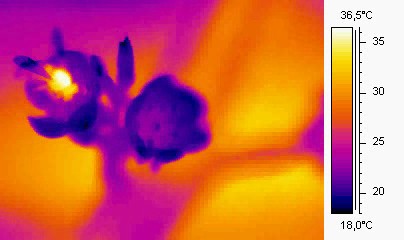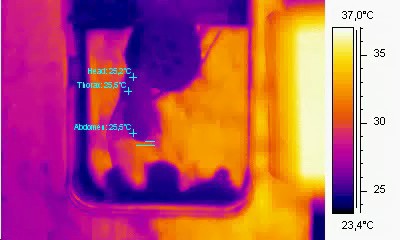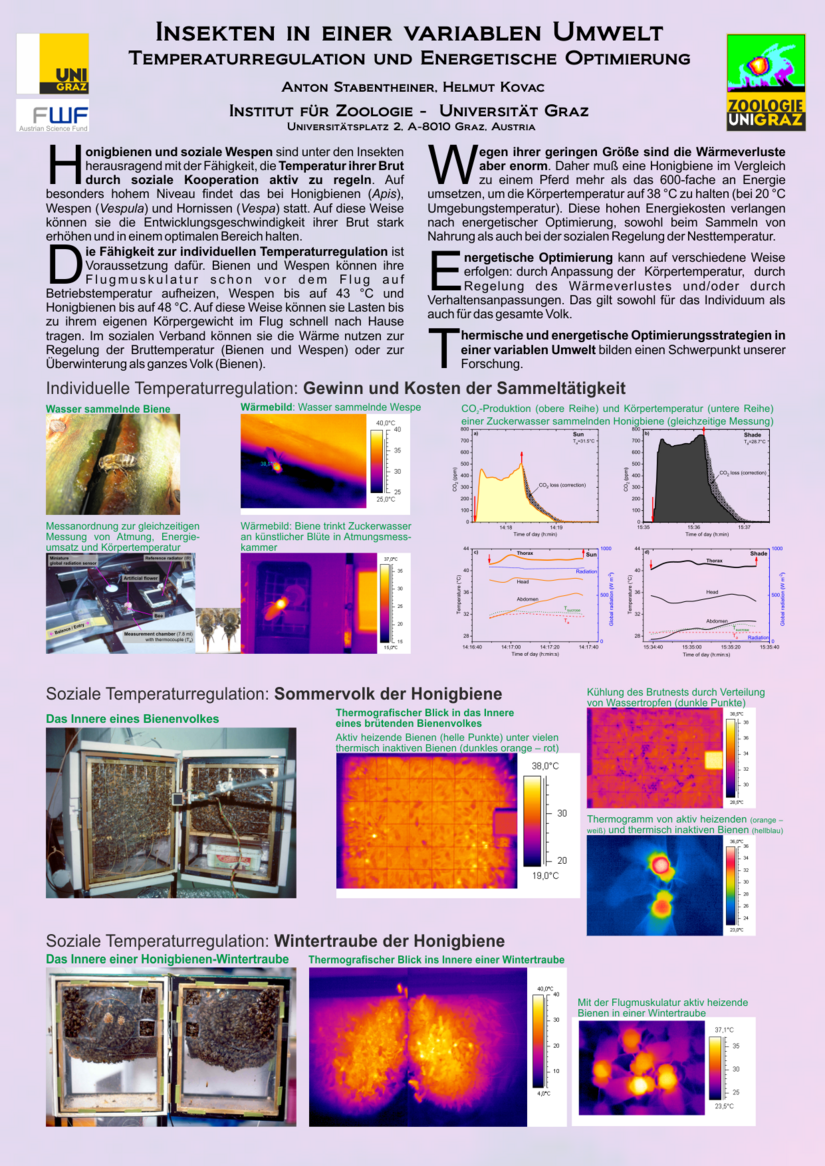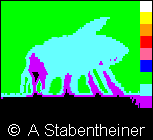Thermal biology, Energetics, Ecophysiology & Ecoethology
Anton Stabentheiner
Institute of Biology, Division of Zoology, University of Graz - Universitätsplatz 2, 8010 Graz, Austria
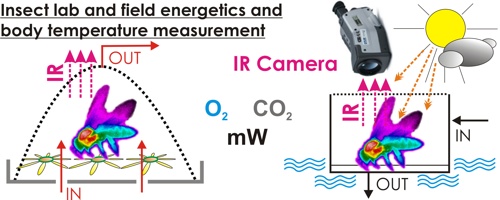
- Stabentheiner A, Mauerhofer T, Willfurth R, Kovac H, Stabentheiner E, Käfer H, Petrocelli I 2024. The costs of overwintering in paper wasps (Polistes dominula and Polistes gallicus): the use of energy stores. Journal of Comparative Physiology B 194, online. DOI: 10.1007/s00360-024-01540-w.
- Kovac H, Nagy JM, Käfer H, Stabentheiner A 2023. Relationship between nest and body temperature and microclimate in the paper wasp Polistes dominula. Insects 14, 886. DOI: 10.3390/insects14110886.
- Kovac H, Käfer H, Petrocelli I, Amstrup AB, Stabentheiner A 2023. The Impact of Climate on the Energetics of Overwintering Paper Wasp Gynes (Polistes dominula and Polistes gallicus). Insects 14, 849. DOI: 10.3390/insects14110849.
- Käfer H, Kovac H, Stabentheiner A 2023. Habitat Temperatures of the Red Firebug, Pyrrhocoris apterus: The Value of Small-Scale Climate Data Measurement. Insects 14, 843. DOI: 10.3390/insects14110843.
- Stabentheiner A, Kovac H 2023. A mixed model of heat exchange in stationary honeybee foragers. Scientific Reports 13, 4655. DOI: 10.1038/s41598-023-31320-5.
- Käfer H, Kovac H, Amstrup AB, Sørensen J, Stabentheiner A 2023. Critical thermal maximum of three life stages of the paper wasp Polistes dominula CHRIST, 1791. Mitt DGaaE 23, in press. DOI: xxx/xxxx.
- Kovac H, Käfer H, Petrocelli I, Amstrup AB, Stabentheiner A 2022. Energetics of Paper Wasps (Polistes sp.) from Differing Climates during the Breeding Season. Insects 13, 800. DOI: 10.3390/insects13090800.
- Stabentheiner A, Nagy JM, Kovac H, Käfer H, Petrocelli I, Turillazzi S 2022. Effect of climate on strategies of nest and body temperature regulation in paper wasps, Polistes biglumis and Polistes gallicus. Scientific Reports 12, 3372. DOI: 10.1038/s41598-022-07279-0.
- Kovac H, Käfer H, Petrocelli I, Stabentheiner A 2022. The respiratory metabolism of overwintering paper wasps gynes (Polistes dominula and Polistes gallicus). Physiological Entomology 47, 62-71. DOI: 10.1111/phen.12376.
- Stabentheiner A, Kovac H, Mandl M, Käfer H 2021. Coping with the cold and fighting the heat: thermal homeostasis of a superorganism, the honeybee colony. Journal of Comparative Physiology A 206, 337-351. DOI: 10.1007/s00359-021-01464-8.
- Kovac H, Kundegraber B, Käfer H, Petrocelli I, Stabentheiner A 2020. Relation between activity, endothermic performance and respiratory metabolism in two paper wasps: Polistes dominula and Polistes gallicus. Comparative Biochemistry and Physiology, Part A 250, 11080411, 1-87. DOI: 10.1016/j.cbpa.2020.110804.
- Käfer H, Kovac H, Simov N, Battisti A, Erregger B, Schmidt AKD, Stabentheiner A 2020. Temperature tolerance and thermal environment of European seed bugs. Insects 11, 197. DOI: 10.3390/insects11030197.
- Kovac H, Käfer H, Stabentheiner A 2020. The Respiratory Metabolism of Polistes biglumis, a Paper Wasp from Mountainous Regions. Insects 11, 165. DOI: 10.3390/insects11030165.
- Kovac H, Käfer H, Stabentheiner A 2019.The Thermoregulatory Behavior of Nectar Foraging Polistine Wasps (Polistes dominula and Polistes gallicus) in Different Climate Conditions. Insects 10, 187. DOI: 10.3390/insects10070187.
- Kovac H, Käfer H, Stabentheiner A 2018. The energetics and thermoregulation of water collecting honeybees. Journal of Comparative Physiology A 204, 783-790. DOI: 10.1007/s00359-018-1278-9.
- Kovac H, Stabentheiner A, Brodschneider R 2018. Foraging strategy of wasps - optimisation of intake rate or efficiency? Journal of Experimental Biology 221, jeb174169. DOI: 10.1242/jeb.174169.
- Erregger B, Kovac H, Stabentheiner A, Hartbauer M, Römer H, Schmidt AKD 2017. Cranking up the heat: Relationships between energetically costly song features and the increase in thorax temperature in male crickets and katydids. Journal of Experimental Biology 220, 2635-2644. DOI: 10.1242/jeb.155846.
- Kovac H, Käfer H, Petrocelli I, Stabentheiner A 2017. Comparison of thermal traits of Polistes dominula and Polistes gallicus, two European paper wasps with strongly differing distribution ranges. Journal of Comparative Physiology B 187, 277-290. DOI: 10.1007/s00360-016-1041-x.
- Stabentheiner A, Kovac H 2016. Honeybee economics: optimisation of foraging in a variable world. Scientific Reports 6, 28339. DOI: 10.1038/srep28339.
- Käfer H, Kovac H, Oswald B, Stabentheiner A 2015. Respiration and metabolism of the resting European paper wasp (Polistes dominulus). Journal of Comparative Physiology B 185, 646-658. DOI: 10.1007/s13592-014-0284-3.
- Kovac H, Stabentheiner A, Brodschneider R 2015. What do foraging wasps optimize in a variable environment, energy investment or body temperature? Journal of Comparative Physiology A 201, 1-10. DOI: 10.1007/s00359-015-1033-4.
- Käfer H, Kovac H, Stabentheiner A 2015. Thermal limits and resting metabolism of the Western corn rootworm (Diabrotica virgifera virgifera, LECONTE). Mitt DGaaE 20, 151-155.
- Stabentheiner A, Kovac H 2014. Energetic optimisation of foraging honeybees: flexible change of strategies in response to environmental challenges. PLoS ONE 9(8), e105432. (1-8). DOI: 10.1371/journal.pone.0105432.
Thermogram of a honeybee foraging sucrose from an artificial flower inside a respiratory measurement chamber (Anton Stabentheiner/Helmut Kovac © 2014):

- Kovac H, Käfer H, Stabentheiner A, Costa C 2014. Metabolism and upper thermal limits of Apis mellifera carnica and A. m. ligustica. Apidologie 45, 664-677. DOI: 10.1007/s13592-014-0284-3.
- Käfer H, Kovac H, Stabentheiner A 2013. Respiration patterns of resting wasps (Vespula sp.). Journal of Insect Physiology 59, 475-486. DOI: 10.1016/j.jinsphys.2013.01.012.
- Stabentheiner A 2013. 5. Temperature, radiation and humidity measurement in honeybees. In: Hartfelder, K; Bitondi, M M G; Brent, C; Guidugli-Lazzarini, K R; Simões, Z L P; Stabentheiner, A; Tanaka, D E; Wang, Y (2013) Standard methods for physiology and biochemistry research in Apis mellifera; Journal of Apicultural Research 52, 26-31 & 40-47; DOI: 10.3896/IBRA.1.52.1.06 (In "V Dietemann, J D Ellis, P Neumann (Eds) The COLOSS BEEBOOK, Volume I: standard methods for Apis mellifera research").
- Stabentheiner A 2013. 6. Respiration and energetics measurement in honeybees. In: Hartfelder, K; Bitondi, M M G; Brent, C; Guidugli-Lazzarini, K R; Simões, Z L P; Stabentheiner, A; Tanaka, D E; Wang, Y (2013) Standard methods for physiology and biochemistry research in Apis mellifera; Journal of Apicultural Research 52, 31-47; DOI: 10.3896/IBRA.1.52.1.06 (In "V Dietemann, J D Ellis, P Neumann (Eds) The COLOSS BEEBOOK, Volume I: standard methods for Apis mellifera research").
- Stabentheiner A, Kovac H, Hetz SK, Käfer H, Stabentheiner G 2012. Assessing honeybee and wasp thermoregulation and energetics - new insights by combination of flow-through respirometry with infrared thermography. Thermochimica Acta 534, 77–86. DOI: 10.1016/j.tca.2012.02.006.
- Kovac H, Stabentheiner A 2012. Does size matter? - Thermoregulation of ‘heavyweight’ and ‘lightweight’ wasps (Vespa crabro and Vespula sp.). Biology Open 1, 848-856. DOI: 10.1242/bio.20121156.
- Käfer H, Kovac H, Stabentheiner A 2012. Resting metabolism and critical thermal maxima of vespine wasps (Vespula sp.). Journal of Insect Physiology 58, 679-689. DOI: 10.1016/j.jinsphys.2012.01.015.
- Hartbauer M, Stabentheiner A, Römer H 2012. Signalling plasticity and energy saving in a tropical bushcricket. Journal of Comparative Physiology A 198, 203-217. DOI: 10.1007/s00359-011-0700-3.
- Stabentheiner A, Kovac H 2012. Energetic and thermal optimization of foraging honeybees in a variable environment. Mitt DGaaE 18, 263-265.
- Käfer H, Kovac H, Stabentheiner A 2012. Resting metabolism of vespine wasps (Vespula sp.) in comparison with other arthropods. Mitt DGaaE 18, 257-262.
- Käfer H, Kovac H, Stabentheiner A 2012. Upper thermal limits of honeybee (Apis mellifera) and yellowjacket (Vespula vulgaris) foragers. Mitt DGaaE 18, 267-270.
- Kovac H, Stabentheiner A 2012. The body temperature of hornets (Vespa crabro) and wasps (Vespula sp.) during takeoff and landing at the nest entrance. Mitt DGaaE 18, 253-256.
- Kovac H, Stabentheiner A 2012. Thermoregulation of foraging honeybees on flowering plants. Mitt DGaaE 18, 271-274.
- Kovac H, Stabentheiner A 2011. Thermoregulation of foraging honeybees on flowering plants - Seasonal variability and influence of radiative heat gain. Ecological Entomology 36, 686-699. DOI: 10.1111/j.1365-2311.2011.01313.x.
Thermographic video of a honeybee foraging from apricot (Prunus armeniaca) (Anton Stabentheiner © 2008): http://video4u.uni-graz.at/.../BL200406_0056~150047.006-150053.108_MEDIUM.mp4
- Stabentheiner A, Kovac H, Brodschneider R 2010. Honeybee colony thermoregulation - regulatory mechanisms and contribution of individuals in dependence on age, location and thermal stress. PLoS ONE 5(1), e8967. (1-13). doi:10.1371/journal.pone.0008967
- Kovac H, Stabentheiner A, Schmaranzer S 2010. Thermoregulation of water foraging honeybees - Balancing of endothermic activity with radiative heat gain and functional requirements. Journal of Insect Physiology 56, 1834-1845.
- Kastberger G, Thenius R, Stabentheiner A & Hepburn R 2009. Aggressive and docile colony defence patterns in Apis mellifera. A retreater-releaser concept. Journal of Insect Behavior 22, 65-85.
- Kovac H, Stabentheiner A, Brodschneider R 2009. Contribution of honeybee drones of different age to colonial thermoregulation. Apidologie 40, 82-95.
- Kovac H, Stabentheiner A, Schmaranzer S 2009. Thermoregulation of water foraging wasps (Vespula sp. and Polistes sp.). Journal of Insect Physiology 55, 959-966.
- Kroder S, Samietz J, Stabentheiner A & Dorn S 2008. Body temperature of the parasitic wasp Pimpla turionellae (Hymenoptera) during host location by vibrational sounding. Physiological Entomology 33, 17-24.
- Kroder S, Samietz J, Stabentheiner A & Dorn S 2008. Influence of temperature on host location and multisensory orientation in the parasitoid Pimpla turionellae (L.) (Hymenoptera). Mitt DGaaE 16, 197-200.
- Stabentheiner A, Kovac H & Schmaranzer S 2007. Thermal behaviour of honeybees during aggressive interactions. Ethology 113, 995-1006.
- Kovac H, Stabentheiner A, Hetz SK, Petz M & Crailsheim K 2007. Respiration of resting honeybees. Journal of Insect Physiology 53, 1250-1261.
Thermographic video of an abdominal respiration movement of a honeybee (Anton Stabentheiner © 2007): http://video4u.uni-graz.at/.../Abdominal respiration movement of a honeybee.mp4
- Stabentheiner A 2005. Individuelle und soziale Thermoregulation der Honigbiene. Entomologica Austriaca 12/2005, 13-22.
- Kovac H & Stabentheiner A 2004. Thermografische Messung der Körpertemperatur von abfliegenden und landenden Drohnen und Arbeiterinnen (Apis mellifera carnica Pollm.) am Nesteingang. Mitt DGaaE 14, 463-466.
- Petz M, Stabentheiner A & Crailsheim K 2004. Respiration of individual honeybee larvae in relation to age and ambient temperature. Journal of Comparative Physiology B 174, 511-518.
- Stabentheiner A, Kovac H & Schmaranzer S 2004. Der Einfluß der Sonnenstrahlung auf die Körpertemperatur Wasser sammelnder Wespen (Paravespula sp.). Mitt DGaaE 14, 451-454.
- Vollmann J, Stabentheiner A & Kovac H 2004. Die Entwicklung der Endothermie bei Honigbienen (Apis mellifera carnica Pollm.). Mitt DGaaE 14, 467-470.
- Stabentheiner A, Pressl H, Papst Th, Hrassnigg N & Crailsheim K 2003. Endothermic heat production in honeybee winter clusters. Journal of Experimental Biology 206, 353-358.
See the heat: Look inside a honeybee winter cluster with infrared thermography (Anton Stabentheiner © 2000):
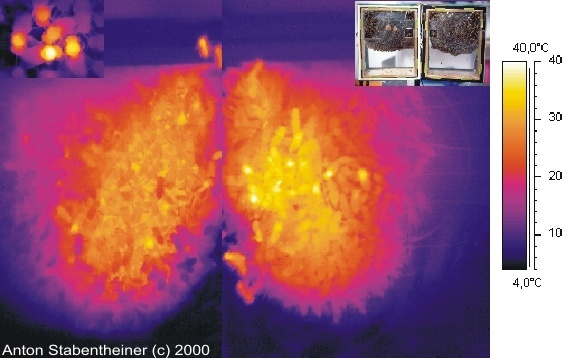
- Stabentheiner A, Vollmann J, Kovac H & Crailsheim K 2003. Oxygen consumption and body temperature of active and resting honeybees. Journal of Insect Physiology 49, 881-889.
- Stabentheiner A, Kovac H & Schmaranzer S 2002. Honeybee nestmate recognition: the thermal behaviour of guards and their examinees. Journal of Experimental Biology 205, 2637-2642.
OK guys, everybody keep cool! Cartoon von Axel Innis in 'This issue', J. Exp. Biol. 205 (2002) (Axel Innis & J. Exp. Biol. © 2002)
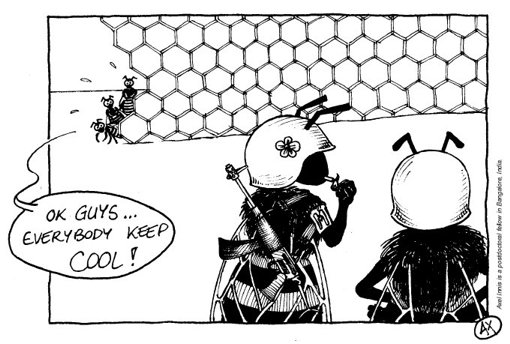
- Stabentheiner A 2001. Thermoregulation of dancing bees: thoracic temperature of pollen and nectar foragers in relation to profitability of foraging and colony need. Journal of Insect Physiology 47, 385-392.
- Kovac H & Stabentheiner A 1999. Effect of food quality on the body temperature of wasps (Paravespula vulgaris). Journal of Insect Physiology 45, 183-190.
- Stabentheiner A & Crailsheim K 1999. The effect of activity level and ambient temperature on thermoregulation in isolated honeybees (Hymenoptera: Apidae). Entomologia Generalis 24, 13-21.
- Crailsheim K, Stabentheiner A, Hrassnigg N & Leonhard B 1999. Oxygen consumption at different activity levels and ambient temperatures in isolated honeybees (Hymenoptera: Apidae). Entomologia Generalis 24, 1-12.
- Germ M, Stabentheiner A & Kastberger G 1997. Seasonal and daily variation of honeybee dancing temperature under constant feeding conditions. Apidologie 28, 385-398.
- Stabentheiner A 1996. Effect of foraging distance on the thermal behavior of honeybees during dancing, walking and trophallaxis. Ethology 102: 360-370.
- Crailsheim K, Hrassnigg, N & Stabentheiner A 1996. Diurnal behavioral differences in forager and nurse honey bees (Apis mellifera carnica Pollm). Apidologie 27: 235-244.
- Stabentheiner A, Kovac H & Hagmüller K 1995. Thermal behavior of round and wagtail dancing honeybees. Journal of Comparative Physiology B 165: 433-444.
- Bermadinger-Stabentheiner E & Stabentheiner A 1995. Dynamics of thermogenesis and structure of epidermal tissues in inflorescences of Arum maculatum L. New Phytologist 131: 41-50.
- Schmaranzer S & Stabentheiner A 1991. Berührungslose Körpertemperaturmessung bei Insekten. Biologie in unserer Zeit 21: 260-262.
- Stabentheiner A 1991. Thermographic Monitoring of the Thermal Behaviour of Dancing Bees. In: The Behaviour and Physiology of Bees (LJ Goodman & RC Fisher, eds). CAB International, Wallingford UK, pp. 89-101 and Frontispiece. ISBN 0-85198-721-4
- Stabentheiner A & Hagmüller K 1991. Sweet Food Means 'Hot Dancing' in Honey Bees. Naturwissenschaften 78: 471-473.
Title page Naturwissenschaften 10/1991: Infrared Thermogram of a dancing honeybee (yellow) with her dance followers (blue-red) (Anton Stabentheiner © 1991)
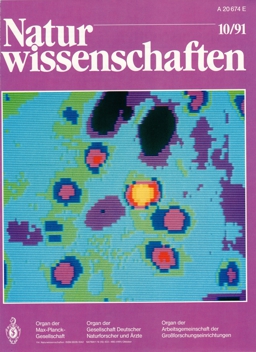
- Hagmüller K, Meggeneder U & Stabentheiner A 1990. Short-term Effekt of Sucrose on O2-Consumption and Brown Adipose Tissue (BAT) Thermogenesis of Young Mice. Zoologische Jahrbücher Physiologie 94: 291-301.
- Kastberger G & Stabentheiner A 1989. Präsoziale Gruppenbildungen bei der Höhlenschrecke Troglophilus cavicola. Mitt Naturwiss Verein Steiermark 119: 129-135.
- Schmaranzer S & Stabentheiner A 1988. Variability of the Thermal Behavior of Honeybees on a Feeding Place. Journal of Comparative Physiol B 158: 135-141.
- Stabentheiner A & Schmaranzer S 1988. Flight-related Thermobiological Investigations of Honeybees (Apis mellifera carnica). In: BIONA-report 6 (Nachtigall W, ed), Akademie der Wissenschaften und Literatur zu Mainz: Gustav Fischer Verlag, Stuttgart, New York, pp 89-102. ISBN 3-437-20434-3, ISBN 0-89574-289-6 (USA), ISSN 0930-0635
- Stabentheiner A, Schmaranzer S, Heran H & Ressi R 1988. Verändertes Thermopräferendum von Jungbienen durch Intoxikation mit Roxion-S (Dimethoat). Mitteilungen Dtsch Ges allg angew Ent 6: 514-520.
- Schmaranzer S, Stabentheiner A & Heran H 1987. Effect of Roxion-S (Dimethoate) on the Body Temperature of the Honey-Bee. In: Chemistry and Biology of Social Insects (Eder J & Rembold H, eds), Verlag J. Peperny, München, pp 241. ISBN 3-925995-01-3.
- Stabentheiner A & Schmaranzer S 1987. Thermographic Determination of Body Temperatures in Honey Bees and Hornets: Calibration and Applications. Thermology 2 (4): 563-572. (1.8 MByte)
Multiple-awarded scientific film:
Film "THERMOGRAFIE BEI BIENEN" ("THERMOGRAPHY OF HONEYBEES") -
Sigurd Schmaranzer, Anton Stabentheiner, Herbert Heran 1987 (272 MB, better quality-but download may last!):
Production: Austrian Bundesinstitut für den Wissenschaftlichen Film, Wien (Director: Siegfried Hermann).
Camera: Visual - Herbert Kerschner, Infrared - Sigurd Schmaranzer & Anton Stabentheiner; Cut: Susanne Thomas; Producers/Creation: Herbert Kerschner & Margit-Andrea Hawlik; Assistance: Hannes Vogelsam; Script: Anton Stabentheiner & Sigurd Schmaranzer; Organisation, honeybee training, scientific creation & commentary: Sigurd Schmaranzer, Anton Stabentheiner & Herbert Heran.
Streaming-Version »» at © The Austrian Media Library (Österreichische Mediathek) (102 MB)
Citations:
- Schmaranzer S, Stabentheiner A & Heran H 1987. Thermografie bei Bienen. Film C 2046 of the ÖWF Wien: Bundesinstitut für den Wissenschaftlichen Film 1987. 16-mm-film, magnetic sound, colour, German commentary.
- Accompanying publication:
Schmaranzer S, Stabentheiner A & Heran H 1988. 'Thermografie bei Bienen'. Wiss Film 38/39: 64-68.
Awards:
- PEKING (People's Republic of China) 1987 - Awarded with a DIPLOMA!: 1st International Congress of the Scientific Film in Peking
- RONDA (Spain) 1987 - Awarded with a SPECIAL PRIZE!: 10th International Week of the Scientific Film
- PARDUBICE (CSFR) 1988 - Awarded with a DIPLOMA!: XXXIX. ISFA-Congress
- BRUSSELS (Belgium) 1988 - Awarded with the 'PRIX DE LA COMMUNICATION SCIENTIFIQUE' of the European Union!: 10. Festival International du Film Scientifique et Technique
